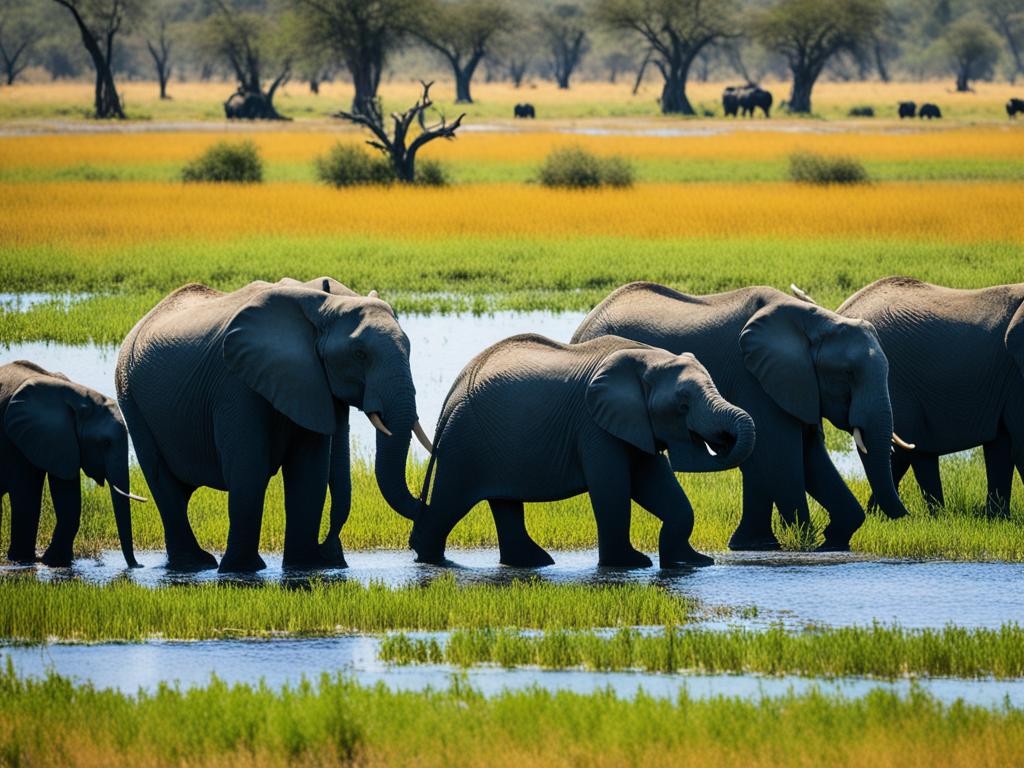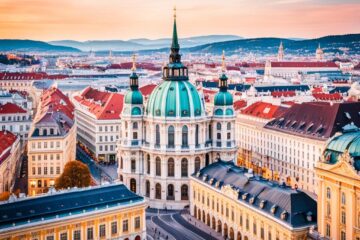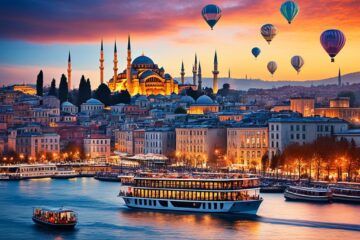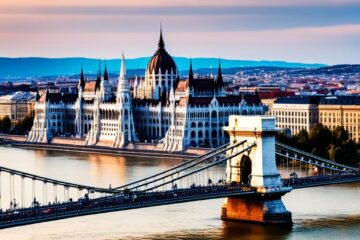Imagine a world where water and land mix, creating a beautiful blur. Picture a place with twisting water paths cutting through lush greenery. And add to that a sky filled with a variety of birds. This is the Okavango Delta, Botswana’s top place for eco-tourism and a wonder of wetlands.
The Okavango Delta is found in northern Botswana, capturing the hearts of all who visit. The flooding of the Okavango River forms this unique spot. It’s famous for its many water paths and the wildlife that lives here. It truly stands out as one of Botswana’s most precious natural treasures.
Key Takeaways
- The Okavango Delta is a unique wetland system located in northern Botswana.
- It is formed by the seasonal flooding of the Okavango River, creating a vast network of intricate waterways.
- The delta is known for its diverse birdlife, with over 400 species recorded.
- The Okavango Delta is a premier eco-tourism destination in Botswana.
- Visitors can explore the delta’s waterways and witness the abundant wildlife in their natural habitat.
The Okavango Delta: Botswana’s Aquatic Masterpiece
The Okavango Delta sits in northern Botswana and is an amazing inland delta. It forms when the Okavango River floods seasonally. This river starts in the Angola highlands and moves into the Kalahari Desert. It designs a big system of waterways, islands, and floodplains.
Unraveling the Delta’s Formation
The Okavango Delta comes to be through a mix of rainfall, evaporation, and river movement over time. These processes have built a unique landscape over the centuries. This ecosystem is home to many species due to these natural events.
The Seasonality of Water Flow
Water in the Okavango Delta changes with the seasons. The biggest floods are from July to September. This flooding is vital for the area’s life, like plants and animals. It makes the inland delta a very special place.
A Thriving Ecosystem in the Heart of the Kalahari
The Okavango Delta thrives in the center of the Kalahari Desert. It’s full of life despite the dry, sandy environment around it. The delta’s rich floodplains and water supports a variety of plants and animals. Its special location creates a unique mix of habitats, leading to a variety of life forms.
Plant Life in the Delta
This area is full of reed beds, papyrus, and other water-loving plants. These plants offer food and shelter to many animals in the delta. The delta’s waterways and floodplains host a great variety of plants. Each one is uniquely suited to the ever-changing, watery environment.
Animal Diversity: From Predators to Prey
The Okavango Delta attracts many animals, both big and small. Here, you can see lions, leopards, and zebras living together. This ecosystem is a lively place for predators and prey to coexist. Birds, reptiles, and small mammals also find a safe place to live in the delta. This makes it a perfect spot for anyone who loves nature.
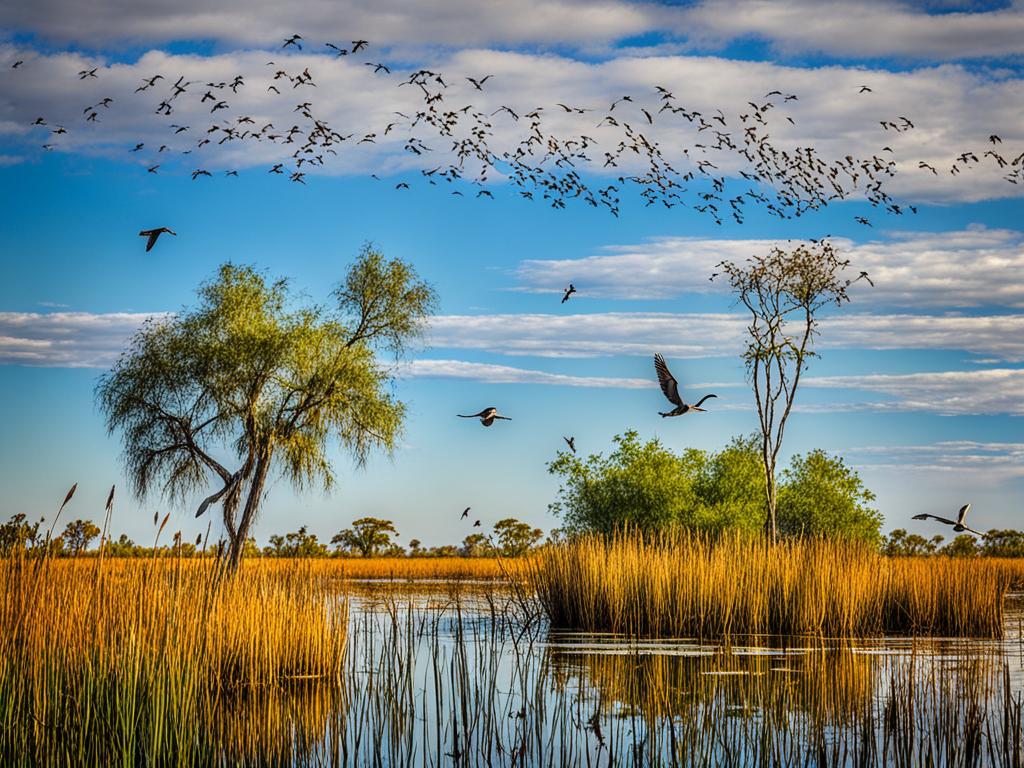
The Okavango Delta’s Significance
The Okavango Delta is a UNESCO World Heritage Site. It’s known for being a key biodiversity area and a globally important ecosystem. The mix of waterways, floodplains, and islands create homes for various plant and animal species not found elsewhere on our planet.
The Okavango Delta is essential in conservation efforts. It helps maintain the region’s ecological balance. This area is critical for saving many species at risk. It does this in the heart of the Kalahari Desert, making it vital for protecting biodiversity.
Besides its natural beauty, the Okavango Delta is culturally rich. Indigenous groups like the Batswana, Bayei, and Hambukushu have deep ties to the delta. Their ways of life and traditions depend on the delta’s waterways and ecosystem. This shows why thorough conservation work is needed to safeguard such a unique place.
Exploring the Delta’s Waterways
Exploring the Okavango Delta can be thrilling by journeying through its intricate channels. You can travel in a mokoro or a motorboat. Either way, you’ll quietly move through the reeds and see amazing wildlife.
Navigating the Intricate Channels
Boat safaris let you get close to the ecosystem of the Okavango Delta. You might see hippos, crocodiles, and many bird species. This is a special way to experience this unique eco-tourism spot.
Wildlife Viewing Adventures
Traveling through the Okavango Delta’s channels is magical. You’ll meet African fish eagles and hippos. It’s an adventure that nature lovers will always remember.
Unique for its Intricate Waterways and Diverse Birdlife
The Okavango Delta is known for its complex waterways. This ecosystem is perfect for many bird species. More than 400 kinds of birds live here, making it a bird-lover’s dream.
Birdwatcher’s Paradise
Imagine seeing an African fish eagle above green plants and a lilac-breasted roller flitting through vegetation. Include herons, storks, egrets, and kingfishers. The delta is not just beautiful; it’s full of life.
Migratory Bird Patterns
The Okavango Delta is a key spot for birds traveling through Africa. In the wet season, it fills with thousands of birds. These include those that wade, birds of prey, and songbirds, adding color and sound to the area.
Conservation Efforts and Challenges
The Okavango Delta is a UNESCO World Heritage Site and highly valued. Botswana’s government, together with non-governmental organizations, work to protect it. They use sustainable tourism initiatives to safeguard the ecosystem. These efforts also help the local economy.
Sustainable Tourism Initiatives
In the Okavango Delta, sustainable tourism is promoted. This way of tourism is responsible and eco-friendly. It makes sure the Okavango Delta‘s resources are used without harming the ecosystem. Rules limit the number of visitors and what activities are allowed. There are also eco-friendly places to stay that fit well with nature.
Threats to the Delta’s Ecosystem
The Okavango Delta still faces threats to its ecosystem, however. Issues like climate change, overuse of water, and projects in other countries can hurt it. Solving these problems needs everyone to work together. This includes governments, non-profits, and local people. Everyone’s effort is crucial to protect this amazing natural area.
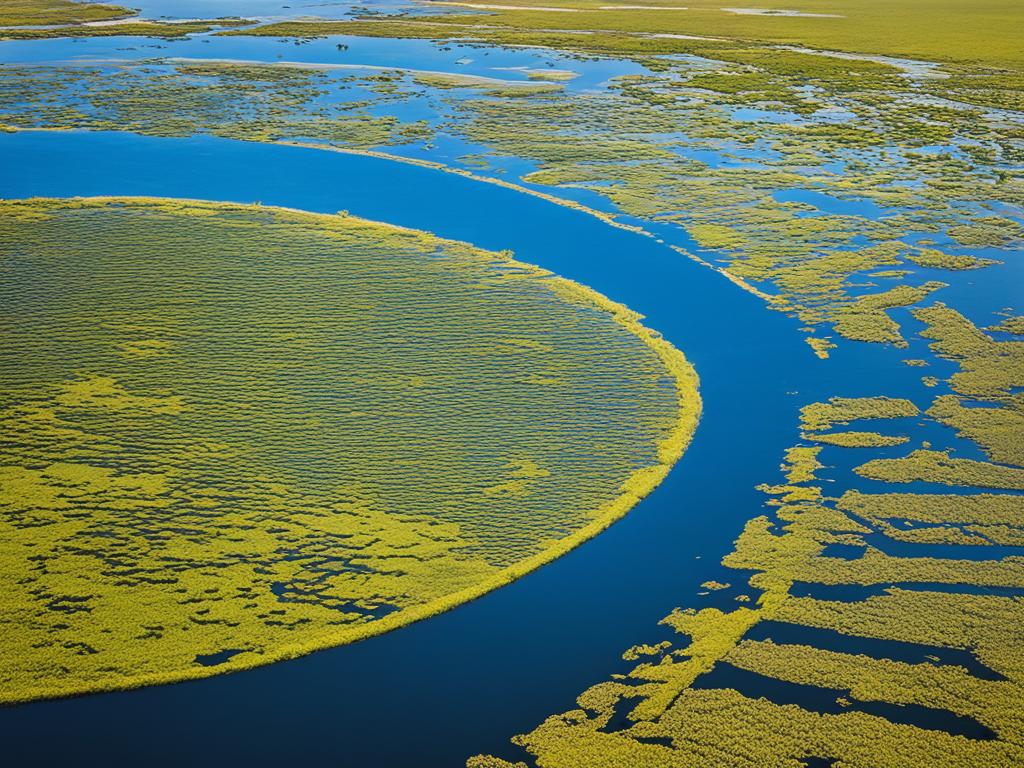
The Delta’s Cultural Significance
The Okavango Delta is very special to the people who’ve lived here for many years. The Batswana, Bayei, and Hambukushu peoples deeply respect its ecosystems. They live in harmony with the natural cycle.
Indigenous Communities and Traditions
For the Batswana, Bayei, and Hambukushu, the Delta is more than just land. It’s part of their core beliefs and ways of life. They’ve used its gifts for ages, fishing and hunting the traditional way. Their homes, the mokaoro, are made from local reeds and grasses. This shows their close bond with nature.
Many special events celebrate the Okavango Delta. These mark the new life brought by the annual flood. They show how everything is connected in nature.
With climate change and more people, the Delta faces tough times. Yet, the wisdom and ways of the Batswana, Bayei, and Hambukushu offer hope. Their sustainable practices can help keep the Delta healthy for the future.
Planning Your Visit to the Okavango Delta
Choosing the right time to visit the Okavango Delta is key to a great eco-tourism trip. The delta’s changing water levels affect what you can do and see.
Best Time to Visit
Many visitors head to the Okavango Delta when it floods most, from July to September. At this time, the delta’s waterways are full, perfect for exploring by mokoro or boat. Animals are also on the move, making it a great time for bird watching and other wildlife activities.
Accommodations and Activities
The Okavango Delta offers a variety of places to stay, catering to different tastes and budgets. You can choose from luxury lodges to simple tented camps. No matter where you stay, you’ll experience the delta’s nature and join in on activities like safari drives and boat trips.
Bird enthusiasts will love the delta, home to over 400 bird species. Birding tours are available, allowing you to see unique birds like the African fish eagle and the lilac-breasted roller.
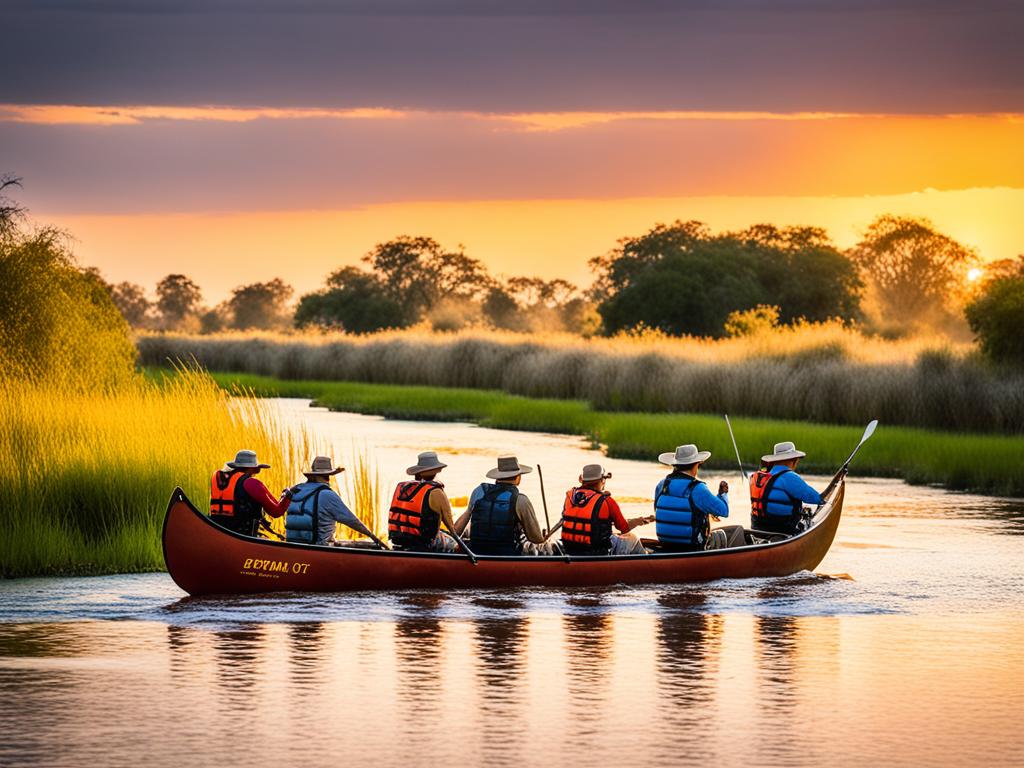
Whether you’re into adventures or want to relax, the Okavango Delta is perfect for all types of travelers. With the right planning, you can see amazing wildlife and enjoy its natural beauty to the fullest.
Conclusion
The Okavango Delta in Botswana is rich in natural beauty. It’s been a favorite for explorers worldwide. A UNESCO World Heritage Site, the delta is a top eco-tourism pick. Visitors get to enjoy a mix of wildlife and a complex network of waterways.
The delta gets its life from the Okavango River’s floods. It’s in the Kalahari Desert, yet full of plants and animals. This makes it perfect for both nature lovers and those who want to protect the earth. Its beauty and importance have led to ongoing conservation efforts.
Exploring the delta’s waterways or watching birdlife is mesmerizing. You can also learn about local cultures. A trip here is both memorable and eye-opening. The delta shows us how amazing our planet is. And, it tells us why we must care for it.
